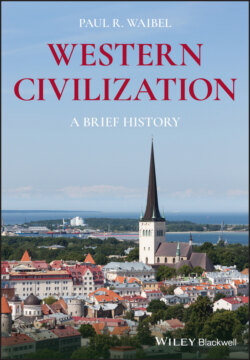Читать книгу Western Civilization - Paul R. Waibel - Страница 22
The Dark Ages (c. 1100–800 BC)
ОглавлениеThe collapse of the Bronze Age during the thirteenth century BC was sudden and devastating. Archeological evidence exists throughout the Eastern Mediterranean region in Greece, Turkey, Israel, Syria, Lebanon, and Egypt. “Within a period of forty to fifty years at the end of the thirteenth and the beginning of the twelfth century,” writes classical studies scholar Robert Drews, “almost every significant city in the eastern Mediterranean world was destroyed, many of them never to be occupied again” (Drews 1993, p. 4).
What caused the collapse remains a mystery. Many explanations have been offered, but recent scholarship suggests that a “perfect storm” of disastrous events including “climate change; drought and famine; earthquakes; invaders; and internal rebellions” led to a kind of “systems collapse” and ushered in a period referred to as the “Dark Ages” throughout the Eastern Mediterranean regain (Weiner 2015). The Dark Ages lasted from c. 1100 BC to 900 BC in the Near East and until c. 800 BC in Greece. Some scholars prefer 776 BC, the date given by Hippias of Elis (c. 460–400 BC) for the first Olympics.
The art of writing disappeared, cities were abandoned, and the population declined. It is estimated that the population fell to about one‐tenth of what it had been in c. 1200 BC. The number of occupied sites in Greece went from about 320 in the thirteenth century to about 40 in the tenth century. What settlements there were during the Dark Ages were small and scattered. Mycenaean culture all but disappeared. The Greeks' self‐identity and cultural values, especially the pursuit of excellence, survived in oral transmission to provide the foundation for the classical period.
